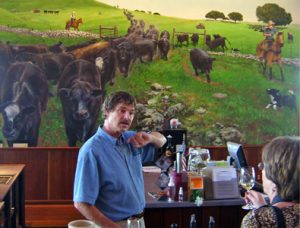By Rick Millikan
 Studying a Napa Valley pamphlet, my spouse Chris and I consider the specific features of 400 valley wineries. Some offer art galleries, gardens, caves, great vistas, picnic grounds, specialty wines, unique architecture, organic vineyards, cooking classes… and even bocce ball pitches.
Studying a Napa Valley pamphlet, my spouse Chris and I consider the specific features of 400 valley wineries. Some offer art galleries, gardens, caves, great vistas, picnic grounds, specialty wines, unique architecture, organic vineyards, cooking classes… and even bocce ball pitches.
Deciding on a few apt wineries, we take a day trip from San Francisco into Napa’s sun-drenched countryside, where vibrant red, yellow and white-blossomed rosebushes front trellised rows of gnarly vines. Complimentary tasting tickets sway us into first stopping at Cosentino Winery. Inside its ivy-covered-brick structure, four Georgian grape groupies invite us join them in their tasty quest. The cheerful sommelier pours a series of reds. Feeling like connoisseurs, we comment: “Nice color!” “Good legs!” “Great body!” Chris giggles. “Good bouquet!” “Delicately delicious!” “Terrific aftertaste…” Not ritually spitting out the wine, we guzzle… and cough up money for two bottles. Those bubbly Georgians buy two cases.
We next travel to wineries boasting awesome views at Napa’s south end. Winding up a quiet road, we soon behold futuristically designed Artesa. Parked above its terraced vineyards, we ascend a long staircase beside a cascading waterfall, stroll past sparkling fountains, reflecting pools and a commanding sculpture…and begin drinking in those promised panoramas of Napa Valley and San Francisco.
Inside, expanses of glass and skylight above the Spanish style courtyard provide natural lighting, bathing its rich wood panels. While awaiting a tour, we taste its premiere sparkling wines and several robust reds.
Showing us first a Codorníu family photo, our guide introduces the distinguished owners. “Their winemaking history began west of Barcelona in the mid-16th century. Sixteen generations later, they’re producing wines worldwide.” In Artesa’s huge cellars, we listen to Gregorian Chants melodiously mellowing mountains of kegs. The guide notes, “Not only is wine a matter of grapes, it’s about oak: choosing the most aromatic species, charring oak barrels to enhance flavors… and protecting this delectable wood from hungry beetles.”
Our last stop, Kirkland Ranch Winery lies eastward. Its three-story log and stone ranch house perches on a hilltop above vineyards and rolling pastureland. At its entrance, mariachis soulfully harmonize while strumming guitars and trumpeting joyful arpeggios.
On the main floor, stuffed elk and cougar heads gaze down on us thirsty folk around a U-shaped bar; a sweeping mural above depicts early ranch days. Exemplifying western hospitality, a lanky cowboy-sommelier pours a range of reds and tells us about their organic vineyards. “And we’ve even got Peruvian shepherds bringing flocks of sheep that graze away weeds and fertilize the vines!”
He smiles knowingly as we giddily recount touristy tales of hopping the local Vallejo ferry to San Francisco, yesterday’s visit to historic Sonoma… and best of all, drinking in wondrous Napa with memorable encounters of the wine kind.
If You Go:
Napa Valley Tourism helps you plan a sunny holiday in this valley north of San Francisco.
About the author:
A former teacher, Rick Millikan encourages healthy, mind-expanding vacations. With writer/photographer partner and wife Chris, Rick recounts snorkels over colorful reefs, rollicking rides around sensational countryside, strolls through historic cities and walks on the wild side. These local and global adventures are syndicated into several Van-Net B.C. papers, appear monthly in two community newspapers and regularly in both Open Road Magazine and Senior Living Magazine. Rick’s passion for cycling propelled past Adventure West columns, Vancouver Province Zen Cyclopath adventures, current Cycling California Magazine articles and ongoing newspaper features. Two of his fictional bicycle tales appear in the anthology Traffic Life.